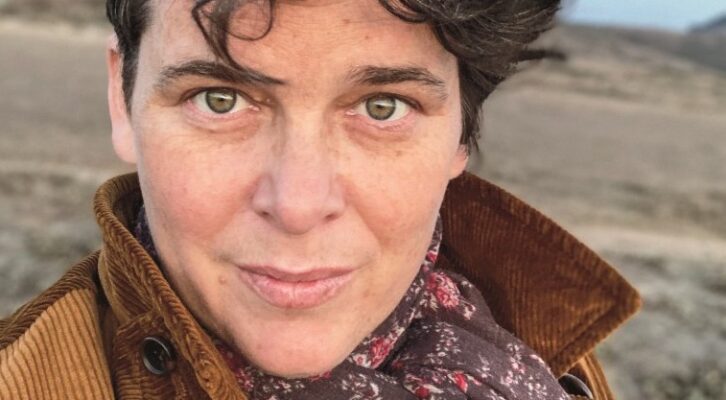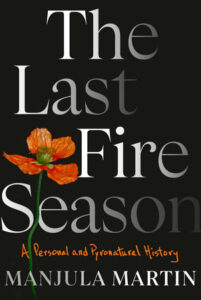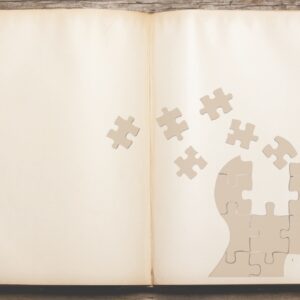
Manjula Martin on Chronicling a World in Constant Turmoil
Jane Ciabattari Talks to the Author of “The Last Fire Season”
In Manjula Martin’s The Last Fire Season, she describes relocating to Sonoma County from San Francisco in 2017, just as the drought-driven wildfire seasons began to accelerate. The turbulence of the years since the pandemic and the out-of-control California wildfires started changed her life, and inspired and shaped her new memoir.
“When the pandemic started, I was working on a novel,” she explains. “Cut to three years later and I’ve just published a memoir. A lot has happened! The Last Fire Season takes place in 2020, which as we all know was also the first year of the pandemic. The events in the book arguably began in 2017, when I moved from the city to the woods during a different horrific wildfire season. At that time, I also began experiencing the health crisis that has accompanied me ever since, in the form of chronic pain, which also plays a role in the book. So 2020 wasn’t my first wildfire experience, but it was a turning point for me in my awareness of fire as a permanent presence in my life, and of the wildfire crisis as one that is linked to others.
“Unfortunately,” she adds, “the years since 2020 have continued to be excellent case examples of what’s often called polycrisis. With the memoir, I’m interested in finding a way to portray life amid all these shifting baselines while also exploring the context—whether historical, ecological, or personal.” Our email conversation took place within miles of each other, in Sonoma County. The fact that I, too, had experienced the chaos of Northern California wildfires coming in the night, with no warning, no option but to run, shortly after relocating from an urban environment (Brooklyn) brought with it an appreciation of how well she captures these intense, nearly indescribable moments. The Last Fire Season is both heart-stoppingly dramatic and profoundly rooted in an understanding of where we fit in the natural world.
*
Jane Ciabattari: How did you decide to structure the book by months, from August through October, according to the dramatic turns of the fire season of 2020 in California?
Manjula Martin: There’s a note I wrote myself at one point in the drafting process that I tacked up above my desk. It says “just write what happened.” The book weaves together a few different threads—the fire crisis, my own bodily pain, and the larger polycrisis of this moment in time. So from the beginning I knew I needed a simple, straightforward structure. A chronological timeline is a classic for a reason!
In addition to following the months of that fire season, each section of the book is inspired by the qualities of a different natural element, with Fire as a constant thread or presence. This concept could easily get a bit precious, so I don’t call a lot of overt attention to it on the page, but it was an important part of my writing process. You’ll see it show up in things like chapter names, and the little icons at the start of each section (which are actually images from element-inspired tattoos that I have, thanks to the book’s graphic designer!).
JC: One chilling aspect of your fire season chronology is how close fire comes. You describe driving in the Sierra “with spotty cell reception over an unpopulated mountain some part of which was already on fire,” with a towering cloud of pyrocumulus smoke visible out the window, to the summit of some 8,300 feet, and coming down the other side safely. A suspenseful trip to read about! And the helicopter rescue of a group of tourists at the reservoir near where you had hiked the day before, “three hundred vacationers…corralled toward by lake by flames on all sides.” (The Creek Fire “surged through 20,000 acres within the span of a day.”) How did you describe the experience from inside the fire? Did you take notes at the time? How did your fire narrative evolve?
MM: Yeah, during those weeks there was such a sense that fire was following me everywhere I went. Yet, interestingly, I didn’t encounter fire face-to-face until I formed a direct relationship with it while learning about prescribed fire, later in the narrative.
In the scene you mention, I actually took a video with my phone, with Miles Davis audible on the car stereo and everything. That moment felt so strangely beautiful and terrible at the same time, I knew I’d later want to prove to myself it happened. Of course, it turned out I didn’t need the video, because it was imprinted permanently in my amygdala! When it came to fire scenes I wasn’t personally present for, I started with my own memory of hearing about them, and then went to research—local news, social media, interviews, and similar reporting sources.
One challenge I encountered in writing the book was portraying fire itself. In the first chapter, I write about how wildfire is always described using these monstrous, ravenous verbs, and so throughout the book I play with different ways of portraying fire, using vocabulary that evolves and changes as my understanding of fire changes throughout the story. This is where you’ll see the elements show up too—in the way fire is embodied, sometimes moving like water, sometimes acting ethereal, and so on.
JC: You have another story you set out to tell after you relocated from San Francisco to rural Sonoma County—the story of how your garden and the forest around it had become your “companion in damage and renewal.” How did you figure a way to weave that into your ongoing fire season narrative? Or vice versa?
MM: I knew I wanted to include the story of my body in the story of the fires, in part because they happened simultaneously (“write what happened”!) but also because these crises are intrinsically connected. Like the rest of the natural world, women’s bodies have historically been idealized as both fonts of fertility and objects of purity, ripe for possession—with harmful and lasting results. Both these stories involve site-specific injuries caused by larger, systemic harms. In the case of the land on which I live, the harms are the result of colonization, extraction, and an exploitative relationship with nature.
In the case of my body, the systems at play include a for-profit healthcare industry and a sociopolitical system obsessed with controlling women’s reproductive health. The interweaving of these two storylines in the book actually came very naturally once I realized that the place where they connected for me—physically as well as metaphorically—was in my garden. So the scenes in the garden became the key to interlacing all this stuff. I think I figured this all out somewhere in the third draft!
JC: How did you research the parts of your story based on Native American use of fire focused on the overall health of the ecosystem (including “prescribed fire,” sometimes referred to as “good fire”) and on renewing important cultural and survival resources?
MM: In my research I read widely, of course, but I think the ideal way to learn about fire is to have relationships with living people who are out there every day putting fire on the land. Traditional ecological knowledge, including that of fire, has been violently suppressed since colonization. As a result, the archives of institutions (many of which were colonialist institutions from inception) aren’t always going to show you the whole story.
So if I was able to interview a person or go visit a place, instead of quote a study, I tried to do so. Some of the awesome Indigenous fire practitioners I had the pleasure of learning from included the staff of TERA—Tribal EcoRestoration Alliance, in Lake County—and a fire expert named Margo Robbins, who is cofounder and president of the Cultural Fire Management Council, based in the Yurok nation in Northern California.
I knew I wanted to include the story of my body in the story of the fires…because these crises are intrinsically connected.
JC: How did you come up with the concept of “future memories,” in which you jump ahead into another moment? For instance, you describe standing in your yard with Sasha Berleman, a fire scientist, wildland firefighter and nonprofit director, looking at wildflowers that have grown in a cleared area. She asks for seeds to sprinkle in burn areas, and says, “Good fire changes fear into action.” All of this is a future moment inserted into the ongoing narrative.
MM: I could talk endlessly about memoir structure choices! But for the sake of brevity, I’ll say that from the beginning I knew I’d place the main narrative in what I’m calling a hard past-tense. (There is probably a better grammar word for this but I do not know it.) That choice was necessary for me to gain distance from the book’s events, which were ongoing in my life, enough so that I could successfully write about them.
So the “past memory” scenes—which are told in the present tense, as are other memories—began as a bit of a formal trick. I needed a way to work in the research and interviews that I conducted after the events of the main storyline. For me, with memoir, these kinds of decisions about the book’s formal structure all serve a purpose: they remind me to question my own perception of time, history, what is and isn’t fixed, and who—and what language—decides that.
JC: How have your attitudes toward fire changed in the course of these years of experiencing and writing about California’s wildfires?
MM: Drastically. The more I learn about fire; the more I see and interact with fire; the more I understand the histories that brought fire to play its current role in the landscape and my life—the less afraid I feel.
JC: How has being in nature, fostering beauty through gardening—“linking” your body more closely to the body of this place” where you lived, served as a healing process?
MM: I think the healing I’ve found in gardening is in the ways gardening makes space for ambivalence. In many ways this book is trying to push against binaries—fire is bad or good, nature is innocent or ravaged, etc. That includes the idea of being “healed by nature,” as well as the concept of being “damaged” at all. My body is all of those things, all the time. It’s also a damn miracle. And that is something I am learning directly from the land. Gardening allows me to inhabit pain and pleasure, powerlessness and control, joy and grief, life and death, care and violence—all of it.
JC: What was the most difficult aspect of writing this memoir?
MM: Living through the events of the book, then immediately signing up to live through the events of the book over and over, in my head, for the next few years, was in retrospect perhaps not a super healthy thing to do! I’m partly joking, but the writing process was more difficult than I anticipated—psychologically because I was still living through it, and physically because of my chronic health issues.
JC: What are you working on now/next?
MM: Everyone says you’re supposed to start your next book before your current book comes out, so you’ll have something to obsess about that is within your control, and also, you know, a career. But I’m not sure when one is supposed to do that. In some ways it feels like I just finished final edits! Last week I did finally have time to clean out my little writing lair for the first time since finishing the memoir, and I put up a big sheet of butcher paper and began mapping a new novel.
The new novel is (roughly) a multi-decade narrative about two sisters who take very different, sometimes surprising, paths in life. It’s about women’s relationships, solitude, and the subversive potential of art during the rise of fascism. So, not at all timely, haha!
__________________________________

The Last Fire Season: A Personal and Pyronatural History by Manjula Martin is available from Pantheon Books, an imprint of Knopf Doubleday Publishing Group, a division of Penguin Random House, LLC.
Jane Ciabattari
Jane Ciabattari, author of the short story collection Stealing the Fire, is a former National Book Critics Circle president (and current NBCC vice president/events), and a member of the Writers Grotto. Her reviews, interviews and cultural criticism have appeared in NPR, BBC Culture, the New York Times Book Review, the Guardian, Bookforum, Paris Review, the Washington Post, Boston Globe, and the Los Angeles Times, among other publications.



















